Rob Grant writes
I was particularly drawn to collaborating with Paul Malone in this exhibition by the parallels and rifts between his anaglyph photographs and binaural sound recording, which I had been exploring. There is an element of immersion through putting on the coloured glasses and/or the headphones; you enter a place that wasn't there before. At the same time, the two stimuli can never have the seamless co-ordination of a film soundtrack. I did not record over Paul's shoulder while he took the photographs and even if I had, the sound has time and the photograph does not. Trying to make a slick soundtrack in the studio, long before or after the photograph was taken, could only succeed if it was familiar to the point of being anodyne. So the sound pieces created for "Synaptic Moment" test the disparities between the "here" of the gallery and the "there" of the landscape that appears through the wall and bursts into noisy life around you, between the still visible place and the moving audible, between the journey and the destination, between the imagined and the remembered.
The objects seen and the events heard existed and happened once, not in this space, and in some cases very far away. They existed there, were captured, recorded, encoded, and then do not exist again as objects and events with extension until the binocular and binaural information is pieced back together by your brain. They are travelling from the original place and time to your experience of here and now, and your attention and experience is moving from Deptford into immersion in the disparate components.
The front of the gallery is spanned by traveling voices overlaid and bereft of a start or finish for a dialogue to form. In one corner, machinery is squeezed so that, like the small details of the anaglyphs, its scale cannot be understood. Inside the darker room at the back of the gallery, two soundscapes on headphones immerse the listener in binaural sound. On one, a long, single-minded walk down corridors, through doors and different rooms, from here to there - or not. On the other, large-scale blocks of sound move over one another in the structure of Iannis Xenakis's "Metastasis", sometimes confirming and sometimes denying each other's reality, sometimes rising in a frenzied argument and sometimes lulling each other into familiar contexts. Throughout I have sought to explore the parallels and the disparities between the binocular and the binaural. The sound material is sometimes coherent with the image, sometimes not.
MP3 binaural sound samples by Rob Grant
Click the titles below to play
 Juxtaposed 272 kb
Juxtaposed 272 kb
 Voices 172 kb
Voices 172 kb
Paul Malone writes
This project continues my interest in creating artworks that investigate the ambiguities between sculptural presence and retinal interpretation. I have been pursuing the technique of 3D anaglyph photography for the past couple of years since I first saw the images, presented in this format, from the surface of Mars. This will be the first showing of this work outside the studio.
These anaglyphs have been created from photographs of geological formations and primitive life forms. They are taken from several locations including the south coast of England, the seashore near Sellafield, sand quarries and the Chemical Beach of County Durham. They instil an enhanced sense of theatre through ambiguous scale, 'closed' horizons and few familiar reference points.
The 3D effect projects the spatial characteristics of the images into an optical void behind the gallery walls. The places in the photographs are simultaneously both here and in a neurologically generated facsimile of their original location. The intension of the exhibition is to re-create the experience of moving within an alien landscape and yet, at the same time, one that is strangely familiar.
The gallery is divided into two halves with an interpretive bridge. The front gallery is naturally lit and contains images on aluminium and framed assemblages highlighting details from a single image. The corridor holds interpretive images of accessibility and inaccessibility. The rear gallery will be unlit and show digital film output through conventional slide projection and lensed-halogen lights.
I thought the APT+1 series would be a good opportunity to showcase these works and looked for a partner that would make for an intriguing experience. Finding Rob Grant, with his interest in binaural soundscapes, seemed the ideal complement to the anaglyphs and has taken this project into new and improbable territory.
The long wall in the dark gallery with lensed halogen projections of tenuous lifeforms
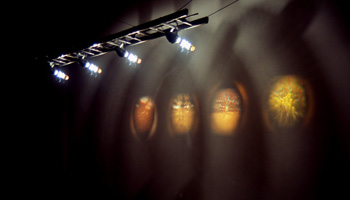

Rob Grant writes about the sound piece ' Synaptic Moment 4':
Given the challenge of composing entirely with sound environments, I could not resist the curiosity in tapping into their musicality. In Synaptic Moment 4, I started with a piece of classical music for a small ensemble which was unusually composed in blocks of sounds, and related each block to a sound environment. This partly on the basis of the durations and timbres but also on how realistically different environments might fit together. For instance, a lyrical solo violin has turned into a wooded valley in Norway, and the occasional soft phrases on celli which accompany it have become dripping water. The two sound like they could almost be one recording. As time passes, the violin part becomes darker and less restful, and the scene fades almost imperceptibly at first from Norway to London; traffic appears, and the trees are being blown more fiercely by the wind. Pizzicato strings dart in, perturbing the tonality further. In environments, this is the sound of washing up: sharp, percussive, and at odds with its neighbours, which are still struggling to hold onto a pastoral atmosphere.
The piece of music is Metastasis by Iannis Xenakis, which was written in 1954 with a revolutionary technique. The macro-structure was determined by the composer (the blocks of sounds or 'clouds of notes') in terms of which instruments will appear when, and within what parameters they will produce pitches, durations, glissandi and densities of notes. The micro-structure (the melody and harmony) within these parameters was then produced by a computer, based on Xenakis's probability calculations. There is an interplay between randomness and control, forming what he called stochastic music.
This interplay is always there in field recordings and found sound sources: they are not carefully crafted to give maximum control and expressiveness as musical instruments are, and they generate happy accidents and nasty shocks. Even when following the macro-structure set out by Xenakis, I found unexpected musical alignments as well as problematic clashes. Apart from standard background noise reduction, I added no special effects or electroacoustic procedures to the recordings; they have something of themselves to tell you, some of which I learnt to recognise as I worked with them, some of which is still baffling. Largely, the editing is done in a rough way because the juxtaposition is important. Nevertheless, it is disconcerting to hear a new source of background hiss and rumble appear or disappear suddenly; usually a sound that is eradicated by careful studio craftsmanship. Finally, I would like to point out that the title of Xenakis's piece, although apt to the themes of travelling without moving in my four sound pieces, was not a factor in choosing it but a coincidental parallel.
Rob Grant, October 2004.
Iannis Xenakis composed and taught composition in Paris from the 1950s to 90s. He is generally regarded as one of the most important composers of the 20th century, and Metastasis is one of his best-known works. After traumatic experiences in the wartime Greek resistance, he studied composition and architecture in Paris and became assistant to Le Corbusier. Metastasis was written to be installed in the Philips pavilion at the Brussels World Fair of 1954, which was architecturally and sonically designed by Xenakis. The curves of the pavilion are generated from some of the same geometric parameters as appear in the music. Xenakis went on to refine his technique of composing stochastic music, and by the early 1960s was able to program a computer (an infeasibly expensive undertaking at the time, hired at £1500 per day) to generate almost every aspect of each note, resulting in some of the most difficult music to perform of that era. The first realisation from the computer was painstakingly transcribed to sheet music and became the definitive composition, but further realisations remain tantalisingly possible. Although chance composition (as light-hearted diversion) had existed much earlier, this was the first serious realisation of a meta-composition.
Information on binaural sound technique:
Binaural sound recording is a technique for capturing realistic stereo images. It uses both your ears to recreate the sense of depth in the space around you, in the same way that having two eyes (bin-ocular vision) gives you a sense of distance.
Small microphones are placed next to, or rest inside your ears like headphones. These capture exactly the sounds that would otherwise be going into your ears. When you hear the sounds around you, your brain uses the subtle differences between sounds as heard by your two ears to tell where something is in the world around you. This is partly due to your head blocking sounds, but also caused by the shape of your ears reflecting sound in, and because sound has to travel further and take slightly longer to reach one ear than the other.
A recording with the left and right channels recorded as close to your ears as possible captures all this detail and then lets your brain then reconstruct the spatial characteristics. This makes for a very convincing stereo effect, especially if heard through headphones. RG
'Beach Rock - Port Cros 1314-4092' : red / blue anaglyph on gutbond aluminium (2x) 100x150cms
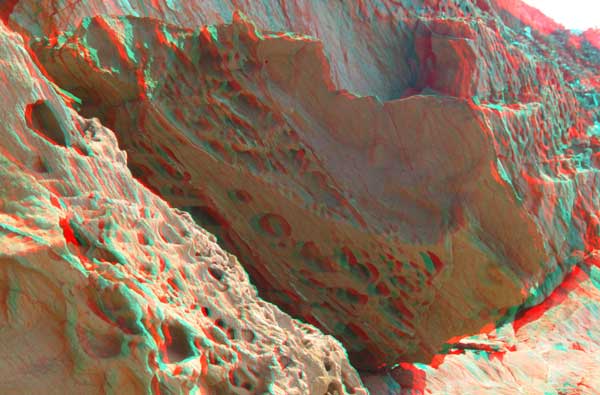
Red / Blue anaglyph creation :
The technique works by ascribing a separate colour filter to each eye of the viewer. By looking through the red / blue glasses, the brain is tricked into seeing an image that retains the original spatial information. The images in this exhibition were taken using a conventional SLR camera - two photos being taken of each subject with a small separation between each - and retain most of the colour information present.
On the computer, the two images are then processed into separate channels in Photoshop and recombined as a single image. There is an element of choice as to where the focal point of the spatial effect is located and this is largely determined by the content. PM
Who is Rob Grant ?
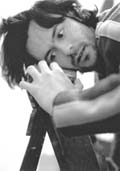
www.corrugated.demon.co.uk
Rob Grant composes and records interactions between music and noise, using the musicality of noises and noises produced from musical instruments. This draws on field recordings, interventions using everyday objects, and transforming inaudible frequencies. He is also interested in exploring the ways in which sound art or music can be conceptual. The primary motivation is to introduce listeners to the overlooked qualities of noises and to explore the ways they can be composed to bring out their musicality. Natural sequences of events, which do not follow expected musical progressions or rhythms, are also a source for composition.
Rob was born in Kirkcaldy in 1974 and grew up in Swaziland and South Africa before returning to the UK to study mathematics and statistics. His experience of sound and music comes from a gradual evolution over the last 14 years from writing experimental rock music to electroacoustic composition to current studies in contemporary classical composition.
Performance and recordings:
August 2004: Sound Postcards from Bow. Audio postcards recorded by public and collaborating local musicians for transmission with personal messages, and compilation in a public access online archive. Included a sound installation at St. Paul's Church and a stall at Bow Festival artists' market.
May 2004: Esemplastic Tuesday. Performance and drawing workshop at the Royal College of Art. A mixture of compositions and improvisations of noise objects and instruments, and a transposition of a movement of Visions de l'Amen by Olivier Messiaen from two pianos to coathangers, toy zither and twelve carrier bags.
June 2003: Four Songs for Mad Pride. Performance at Midsummer Petefest and benefit CD, with Melanie Clifford, of four songs subverting pop idiom to introduce elements of our compositional techniques.
April 2003: Washing Machine at Grand Parade. A double CD-R recording of a washing machine cycle to highlight the rich timbres and gradual variations. Also contains a version speeded up 43 times to capture the very low frequencies (the latter broadcast on Resonance FM).
February 2003: Introduction for Framework. Field recording specifically for broadcast on Resonance FM. Subsequently released on fundraising CD "Best of Framework 2003" by London Musicians' Collective.
Work in progress:
Single score percussion tableaux. Collections of everyday objects with their own unique composition and instructions for one or more player of any level of experience.
341. Field recording snapshot of the bus route, between Islington and Harringay, with double narration charting the socioeconomic changes over the journey.
Perfect Pieces of Music. Series of extremely short pieces conveying the enjoyment to be had from single chords or notes if the timbre is pleasing.
Five Pieces About Music. Series of electroacoustic compositions in early stages of development, experiments in creating conceptual sound art that is also music, about music. Subject matter such as virtuosity opposed to invention and overfamiliarity.
Who is Paul Malone ?
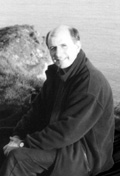
www.a2arts.co.uk/malone
My art as a whole is most easily classed as 'wall sculpture' although this covers a range of techniques from extended installations to digital projection and machined artefacts.
The latest works I am involved with are the 3D anaglyphs containing imagery gathered from forgotten or polluted landscapes.
With some of the early work there was an intention to assemble completely new materials, the essential properties of which could only be guessed at by the optical presence of their surfaces.
A readiness to draw false assumptions from only half perceived visual stimulus is an important part of my working process and something I enjoy presenting to people in the form of these material objects.
I have lived in towns and cities all my life and yet have been aware that above is a landscape of grandeur and mystery that is equally compelling. Execute a simple inversion and suddenly there is a desert, a range of mountains and the familiarity of the city turns into a kind of weather. It is not a vista but a volume and inhabited by artefacts that have their own unique urban architecture. Not just the things themselves but the meta-structures of invisible organisation both natural and man-made.
Inhabiting this space too is a whole history of conceptual endeavour. Its very inaccessibility lends itself to speculation and interpretation based on the most flimsy evidence – a few grains of photographic emulsion, a mathematical tower of cards or an ethical conviction. The charting of this world has only just begun, with heroic yet barely adequate tools. There have been audacious attempts at understanding; some we still live with, some fallen by the wayside. As an artist it is these narratives that I find the most intriguing. For me art is an opportunity to see where these arcane and forgotten theories would have lead - playful departures, now thought of as irrelevant or heretical, to the imperatives of unitarian structures.
Paul Malone was born in Warrington, Cheshire (near Manchester, U.K.) in 1953.
He studied Fine Art at Reading University for B.A. Degree in 1976 and MFA in Sculpture at the Royal Collage of Art in 1980.
Since leaving college he has worked in studios based in the London districts of Waterloo, Greenwich and, most recently, Art in Perpetuity in Deptford.
He has exhibited extensively in the U.K. over the intevening years and recently in Frankfurt and Brussels.

FastCounter by bCentral
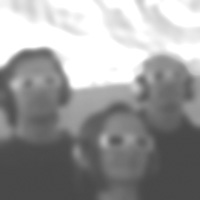
 Juxtaposed 272 kb
Juxtaposed 272 kb





